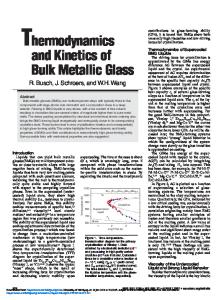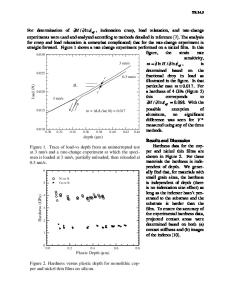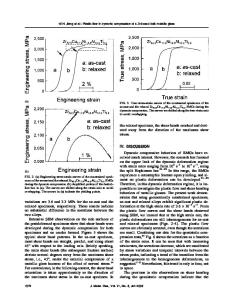Change in Activation Volume for Plastic Deformation of Zr-based Bulk Metallic Glass following Annealing
- PDF / 367,407 Bytes
- 6 Pages / 612 x 792 pts (letter) Page_size
- 105 Downloads / 403 Views
1048-Z03-08
Change in Activation Volume for Plastic Deformation of Zr-based Bulk Metallic Glass following Annealing Jonathan B. Puthoff1, Donald S. Stone1,2, Hongbo Cao1, and Paul M. Voyles1,2 1 Materials Science Program, University of Wisconsin - Madison, 1509 University Avenue, Madison, WI, 53706 2 Department of Materials Science & Engineering, University of Wisconsin - Madison, 1509 University Avenue, Madison, WI, 53706 ABSTRACT We performed nanoindentation creep experiments on the bulk metallic glass Zr54Cu38Al8 in an effort to measure the scale of the individual deformation events responsible for plastic deformation. From a nanoindentation creep experiment, we can determine V*, the activation volume, which we interpret as the volume of a shear transformation zone (STZ) multiplied by the shear strain undergone by the STZ during thermal activation. For the as-cast alloy hardness, H, is 5.33 ± 0.06 GPa, and V* is 87 ± 5 Å3. The alloy was then annealed near Tg for 24 hr and retested. No crystallization occurred during annealing as verified by XRD and TEM. Following annealing H increased to 7.36 ± 0.08 GPa and V* increased to 160 ± 10 Å3. We interpret the change in V* as arising from an increase in the number of atoms involved in the STZ. INTRODUCTION Bulk metallic glasses (BMG's) [1-3] typically exhibit a large yield strength-to-modulus ratio [4] and superplastic formability at elevated temperatures [5], making them potentially useful for applications. Many alloy systems which exhibit good glass-forming ability have been identified, and ingots with diameters of up to 7.2 cm have been fabricated [6]. With the advent of these more easily processed alloys, BMG's appear to be on the threshold of widespread implementation. However, knowledge of the structure-property relations in BMG's is far from complete. A more complete understanding of plasticity in BMG’s is crucial to the application of these materials for structural purposes. The flow properties have historically been described by the free-volume (cf. [7]) theory of Spaepen [8] and the defect theory of Argon [9]. Argon's model provides for flow localization, which occurs by the ensemble shearing of groups of 10-100 atoms dubbed “shear transformation zones” (STZ's). Evidence for the existence of STZ's comes from molecular dynamics simulations performed by Falk and Langer [10], who observed regions of the glass in which strains were non-affine relative to the rest of the glass. In the STZ model of glass deformation, the plasticity of the glass may be interpreted in the context of STZ activation. In heterogeneous flow, the macroscopic strain rate, ε& , is expected to be given by an Eyering rate equation of the form ⎡
ε& = ε&0 c exp ⎢− ⎣
W (G, Ω;τ ) ⎤ ⎥. k BT ⎦
ε&0 is a material-dependent rate constant and c is the concentration of STZ's. Following
(1)
Johnson and Samwer [11], the activation barrier energy, W, is proportional to the shear modulus, G, and the STZ volume, Ω, and is a function of the applied stress, τ . A co-operative shear model (CSM) predicts th
Data Loading...











